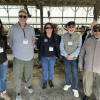So exactly what is biodynamic agriculture?
What is biodynamic farming?, many have asked. So I decided to address it this week. Regarding wine, it appears to be a crock of promotional hoohah. First blush it sounds very interesting. For example this sounds like a winner. "Biodynamic is similar to other organic approaches - it emphasizes the use of manures and composts and excludes the use of artificial chemicals on soil and plants." The following, however, gives me pause. Burying ground quartz, stuffed into the horn of a cow, which are said to harvest "cosmic forces in the soil" and “treats soil fertility, plant growth, and livestock care as interrelated, emphasizing the spiritual and mystical perspective."
According to an article in Wikipedia that was well footnoted, “No difference in beneficial outcomes has been scientifically established between certified biodynamic agricultural techniques and similar organic and integrated farming practices.” Critics have characterized biodynamic agriculture, which was initially exposited in 1924 by philosopher Rudolf Steiner through a series of lectures, as pseudoscience due to a lack of strong evidence for its efficacy and skepticism about aspects criticized as being magical thinking.
All the above is background noise for me. My main contention is that while biodynamic sounds great for lettuce, corn and soybeans, etc., most of the great wine juice of the world is grown on rock piles, gravel bars, chalk hills, long time dried river beds, arroyos, dry creek beds and sun-drenched slopes at higher elevations with temperature extremes from night to day and a dire lack of water.
In fact, the bane of most high-quality wine is fertile ground and a “wet” year. I can’t begin to tell you how many great wine makers I have heard exclaim that it is the “terroir” stress, old vines and low yields that are directly responsible for producing great, long-lived wine. I contend the demand for instant gratification, cheap and large quantities and cash flow have led to drip irrigation, fertilizing vineyards and “trellis management.” More sun equals faster and/or ripening.
These have lowered stress, increased yields, lowering tannin levels, thereby exacerbating the glut of cheap, ready-to-drink tomorrow wine. As Steve Martin exclaimed in “The Jerk," when asked if he wanted more Chateau Latour, ”No more of the 1966. Let’s splurge! Bring us some of the fresh wine! The freshest…no more of the old stuff.”
Risking being preachy, many of us drink wine before it is deemed ”ready to drink" by the winemaker and/or experts. According to our experience, “new wine” is the proper profile. I’m reminded of this when I do a vertical tasting with less-experienced winos.
They will often comment to the effect, "Wow, these 'old wines' taste a lot better or different.” They’re not as “sour or puckery or sharp” or “Now I get it.” The wine trade is catering to the large, instant-gratification group, especially since the conglomerates are glomming the small, elite producers.
Holding wine for several years before release is expensive, particularly for the high-risk-borrowing category. Few, if any, small, independent, wine producers are getting loans under 4 percent.
Mulderbosch Faithful Hound 2013 is a solid 89 plus two price points under $21. Wine worth exploring, perennially rated around 90 points. A wonderful opportunity to observe the effects of vintage, winemaker and ownership change by having your fav wine shop order a mixed case from 2008-13, two each. Expect to pay a premium and wait a bit; 2009, 2011 of the six vintages are best until now. The 2013 are lovely; 18 months in 60 percent new and 40 percent second fill French oak, blended of Cab Franc 44 percent, Cab Sau 30 percent, Merlot 18 percent, Petit Verdot 4 percent, Malbec 4 percent. Dark plum with garnet rim they open with a swirl to cherry, forest floor, tobacco and cedar aromas. On the palate fairly tannic with loads of berry, some chocolate and more oak-driven wo notes. Finishes long and clean. Color, fruit, tannin, oak, acid profile says cellar me several years. These are very affordable to cellar but the vertical is the way to go. Charles Banks, formerly of Screaming Eagle, bought up this winery, and the 2011 with new winemaker Adam Mason made WS top 100 in 2014.
Email John McDonald at chjonmc@yahoo.com.























































